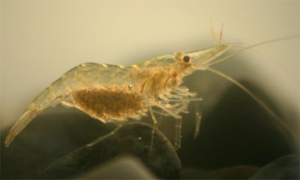Summary
This project evaluated three shoreline cleaner products (Accell Clean SWA, PES-51, and CytoSol). We compared the biological effects and chemical interactions of the products with oil using a simulated salt marsh ecosystem. We also established acute toxicity of the products alone and in conjunction with oil in adult and larval grass shrimp and determined sublethal and developmental effects. The oil removal efficiency of the products was evaluated using artificial substrates in laboratory trials.
Why We Care
One remediation strategy for stranded oil on shorelines is the use of chemical cleaning agents. Shoreline cleaning products are designed to promote rapid release of oil from a substrate surface, including mangroves and salt marsh vegetation, sediments, and hard substrates such as seawalls. While the cleaners can be valuable tools to protect sensitive habitats from the toxic effects of oil, the potential for toxic responses to the cleaning agents by coastal species must also be considered.
What We Did/Are Doing

This research project assessed the toxicity of three shoreline cleaners (PES-51, CytoSol, and Accell Clean SWA) in laboratory and mesocosm exposures, determined petroleum hydrocarbon distributions in water and sediment, and evaluated efficacy of each SLC in removing oil from artificial substrates. The mesocosm system included tidal creek sediments, marsh grass, juvenile clams, mud minnows, grass shrimp, mud snails, polychaetes, amphipods, and the natural microbial community. There were five treatments (Control, Oil, Oil+CytoSol, Oil+Accell, Oil+PES-51) with four replicate mesocosms per treatment. Oil (Louisiana Sweet Crude) was applied to ceramic tiles in each system, treated with the shoreline cleaner products, and monitored for 30 days. Biological endpoints included fish, shrimp, snail, polychaete, amphipod, and clam survival, as well as clam growth, lipid peroxidation biomarker of enzyme activity (fish, snail, and clam), and impacts to salt marsh vegetation. Water samples were also collected and analyzed for microbial endpoints including heterotrophic bacterial density, and Vibrio bacteria (V. vulnificus and V. parahaemolyticus) densities. Additional water and sediment samples were collected and preserved for microbial community composition analysis (specifically to assess groups of oil degrading bacteria) using nucleic acid sequencing methods. Water and sediment samples for chemical analysis of total extractable hydrocarbons (TEH) and polycyclic aromatic hydrocarbons (PAHs) were collected at multiple time points throughout the study. Laboratory experiments were also conducted using the grass shrimp (Palaemonetes pugio) to determine sensitivity to the different shoreline cleaner products alone and in combination with oil.
What We Found
The greatest animal mortality in the mesocosm experiment occurred in the Oil+Accell Clean treatment. Clam growth was reduced in the Oil+Accell Clean and CytoSol treatments. There was an increase in bacterial densities and a decrease in dissolved oxygen content in the Oil+Accell Clean treatment. Water column hydrocarbon concentrations were greatest in the Oil+Accell and Oil+CytoSol treatments after 7 days, but decreased rapidly in all treatments after 30 days. In laboratory testing, grass shrimp were most sensitive to Accell Clean, followed by PES-51, then CytoSol. Larval shrimp were more sensitive than adults and effects on larval growth and development were observed. Accell Clean prepared as a chemically-enhanced water accommodated fraction (CEWAF) with LSC oil was observed to act as a dispersant, mixing oil into solution and yielding greater concentrations of soluble hydrocarbons than PES-51 prepared as a CEWAF. Results of the oil-removal efficiency study with shoreline cleaners indicate that PES-51 and CytoSol were more effective at removing oil from the artificial substrates than Accell Clean.
Next Steps
Working with OR&R, we will provide ecosystem assessments of oil spill mitigation products for use in spill response.
Impact/Benefits of our Work
The data generated from this study will be used to inform response and management decisions during oil spill events. In addition, the information gleaned from this study may address public concerns about the use of shoreline cleaners in oil-spill response.

